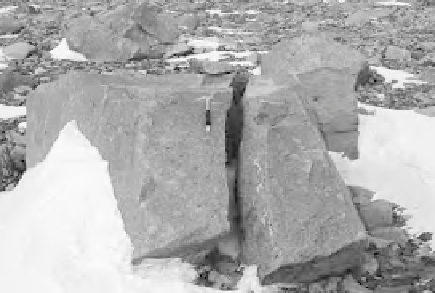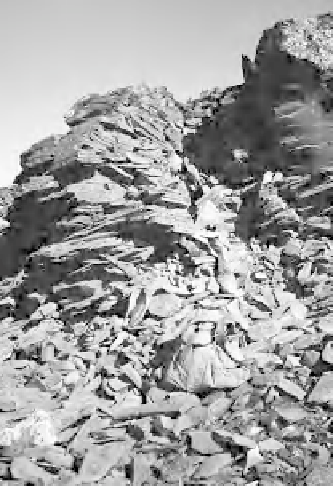Geology Reference
In-Depth Information
(A)
(B)
Figure
4.7.
Examples of bedrock disintegration under cold-climate conditions. (A) Fractured,
dark brown, fi ne-grained diorite boulder lying on ablation till surface (“Younger Drift”) in vicinity
of Simpson Crags, Northern Victoria Land, Antarctica. The disintegration was probably caused by
thermal stress. (B) In-situ bedrock disintegration of fi ssile sandstone of Jurassic age, Prince Patrick
Island, NWT, Canada. Disintegration is presumably by subaerial frost action.
years, there has been renewed emphasis placed upon thermal stress as a possible mecha-
nism. Here, we discuss both mechanisms and conclude that each may be effective under
different circumstances and for different rock types. For example, a cracked granodiorite
boulder lying on an ablation till surface is almost certainly the result of thermal stress
(Figure 4.7A) while an exposure of shattered fi ssile sandstone is almost certainly the result
of frost action and ice segregation (Figure 4.7B). More problematic are the angular rock-
rubble accumulations that veneer many upland surfaces (Dahl, 1966; Dredge, 1992; Ives,
1966). These are the present-day equivalents of the so-called “periglacial facies” of Loz-
inski (see Chapter 1).
4.5.1. Frost Action and Ice Segregation
Several investigators stress the role of micro-fractures in bedrock as the method by which
water penetrates bedrock and subsequently freezes to cause rock disintegration. However,
when this cracking takes place, and what causes it, are still not clear. For example, using
sandstone samples and evidence derived from acoustic emissions, B. Hallet et al. (1991)
inferred that freezing-induced micro-fracture propagation occurred at temperatures
between
6 °C. Earlier, it had been found that high frequencies of freeze-thaw
cycles are not necessary for crack propagation and that the latter can occur at tempera-
tures anywhere between
−
3 °C and
−
15 °C (Walder and Hallet, 1985, 1986). More recent
studies (Matsuoka, 2001a; Prick, 2003) report upon the monitoring of rock temperatures,
−
4 °C and
−


